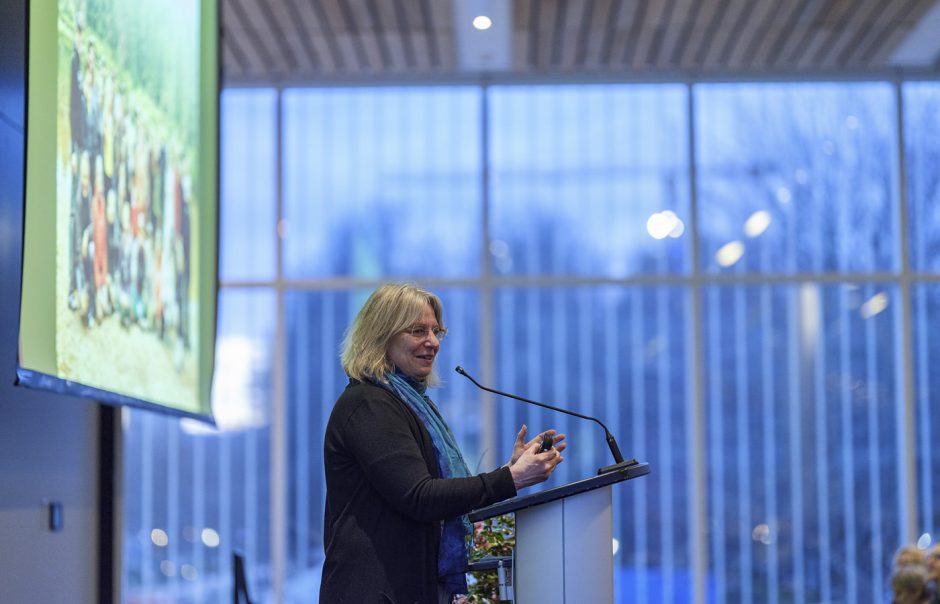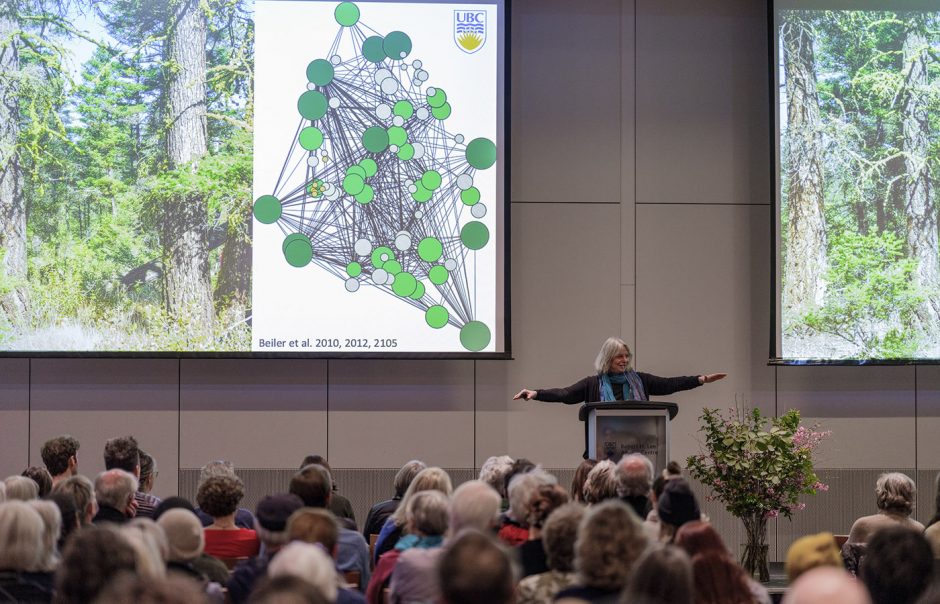
Earlier this month, Dr. Suzanne Simard was warmly welcomed as the speaker for the Peter Wharton Lecture. Peter Wharton was an admired curator of UBC Botanical l Garden, and in honour of his contributions to horticulture and plant conservation, and in consultation with his family, UBC Botanical Garden established the Peter Wharton Memorial Fund to support lectures on plant conservation and biodiversity.
Dr. Simard BSF’83 is a professor of Forest Ecology at the UBC Faculty of Forestry and is the leader of the Mother Tree Project (MTP) and Mother Tree Network (MTN). She holds a Ph.D. and MSc in Forest Ecology from Oregon State University and a BSF in Forest Resource Management from UBC. As the leader of the MTP and MTN, Dr. Simard aims to find ways to protect and restore biodiversity and forest regeneration. She is deeply passionate about forest health and has spent over 25 years researching how trees communicate through underground mycorrhizal networks, also known as fungal networks. This year’s Peter Wharton Lecture was focused on how the forest’s overall health and the impact of deforestation are acutely linked to what Dr. Simard describes as mycorrhizal networks.

Why are old-growth forests important?
Dr. Simard explains that old-growth forests are carbon-rich and biodiverse due to the years they have had to regenerate and create connections through underground mycorrhizal networks. These networks help the trees communicate with one another to maintain the health of the forest. Old-growth forests are extremely important – not only are they biodiverse, but they also have a notable ability to store carbon and clean water providing for life on Earth. They are home to many at-risk species that depend on the important characteristics only present in old-growth forests.
How can we protect old-growth forests?
Sadly, only about two to three percent of old-growth forests remain intact in British Columbia. Whether positive or negative, our local actions have consequences related to climate change globally. Dr. Simard shares a few ways we can help limit the negative consequences:
1. First Nations and local community stewardship.
In reviewing where the highest amounts of biodiversity remain, most of them are situated in areas that are managed by Indigenous people. Indigenous communities’ conservation of old-growth forests is intrinsically linked to resource care. Through stewardship, Indigenous communities are deeply connected with the environment, the health of different species and the natural conditions of their resources. Stewardship practices remain conscious of carbon footprints and ensure that biodiversity is maintained. Dr. Simard shares that it is essential for us to be working towards restoring Indigenous rights and titles to advocate for the importance of Indigenous knowledge and work together to improve environmental sustainability.
2. Old-growth and primary forest conservation.
To challenge the climate crisis, it is especially important that we do everything we can to protect the old-growth and primary forests. Carbon-rich and biodiverse, these forests have never been logged before and have intact carbon pools. Once these forests are clear-cut or logged, important trees are removed from the fungal network, limiting the amount of carbon in and above the soil which disrupts ecosystems globally. While regenerating forests and planting new trees is helpful, they can’t immediately replace the biodiverse and carbon-rich environment that the old-growth and primary forests once provided.
3. Improved forest management in 2nd growth forests.
When we harvest from forests, it is important to remain conscious of where we are extracting our resources from. Logging in a more conscious manner – using second-growth forests and choosing to leave carbon pools and biodiversity intact allows the forest to recover. We have the power to change practices. To make a difference, contact your Member of the Legislative Assembly (MLA) and draw attention to large industrial corporations harming the forests.
4. Restoration of planted forests.
There are many degraded plantations that we can work towards recovering. The only way for us to do this is to do it ourselves. Dr. Simard encourages us to go out into nature and help restore these plantations, which as a result helps regenerate carbon and biodiversity. Additionally, returning/repatriating Indigenous lands and territories to traditional stewardship practices will help with restoring and maintaining biodiversity. Through these actions, we can work towards a healthier and more sustainable environment.
Submitted by Ariel Baena-Tan, Marketing and Communications Assistant
